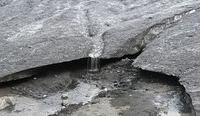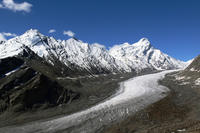-
Detection aircraft surveys 600 miles of PG&E California pipeline for gas leaks
PG&E’s transmission pipeline is routinely surveyed each year, typically by ground crews; accessing rural areas with difficult terrain, however, can be time consuming, expensive, and unsafe for crews on the ground; aerial surveys often look for dead vegetation as an indicator of gas leaks
-
-
Sea-levels rising faster than IPCC projections
Sea-levels are rising 60 percent faster than the Intergovernmental Panel on Climate Change’s (IPCC) central projections, new research suggests; the study involved an analysis of global temperatures and sea-level data over the past two decades, comparing them both to projections made in the IPCC’s third and fourth assessment reports
-
-
“Intra-seasonal” variability in sea-level change
The effects of storm surge and sea-level rise have become topics of everyday conversation in the days and weeks following Hurricane Sandy’s catastrophic landfall along the mid-Atlantic coast; new research is throwing light on another, less-familiar component of sea-level variability — the “intra-seasonal” changes that occupy the middle ground between rapid, storm-related surges in sea level and the long-term increase in sea level due to global climate change
-
-
American West's changing climate means economic changes, too
The State of the West Symposium, hosted by the Bill Lane Center for the American West and the Stanford Institute for Economic Policy Research, featured a discussion of the Western United States’ future of extreme heat, declining snowpack, and what it all means for the region’s industry, electricity generation, and policy
-
-
Blame, responsibility, and demand for change following floods
New research shows concerns about governmental failure to act effectively and fairly in the aftermath of extreme weather events can affect the degree to which residents are willing to protect themselves; the findings could prove key to establishing how society should evolve to cope with more turbulent weather and more frequent mega storms
-
-
DHS awards $23.6 million to fund development of new software analysis technology
DHS awarded a $23.6 million grant to the Morgridge Institute for Research at the University of Wisconsin-Madison to create the Software Assurance Marketplace, which, over the next five years, will work closely with developers of new software analysis technology and the open source community to advance the security of software; initial operating capabilities for the Software Assurance Marketplace will include the ability continuously to test up to 100 open-source software packages against five software assurance tools on eight platforms, including Macintosh, Linux, and Windows
-
-
New method to rid inboxes of unsolicited e-mail
Spam used to be text-based, but has recently turned high-tech, using layers of images to fool automatic filters; thanks to some sophisticated new cyber-sleuthing, researchers at are working toward a cure
-
-
Humble microbes fighting harmful greenhouse gas
The environment has a more formidable opponent than carbon dioxide; another greenhouse gas, nitrous oxide, is 300 times more potent and also destroys the ozone layer each time it is released into the atmosphere through agricultural practices, sewage treatment, and fossil fuel combustion; luckily, nature has a larger army than previously thought combating this greenhouse gas
-
-
Warming to shift heavy rainfall patterns across U.K.
Researchers investigating the potential changes in extreme rainfall patterns across the United Kingdom as a result of global warming have found that in some regions of the country, the time of year when we see the heaviest rainfall is set to shift
-
-
Greenhouse gas concentrations in the atmosphere reach new record
The amount of greenhouse gases in the atmosphere reached a new record high in 2011, according to the World Meteorological Organization (WMO); between 1990 and 2011 there was a 30 percent increase in radiative forcing — the warming effect on our climate — because of carbon dioxide (CO2) and other heat-trapping long-lived gases; a new WMO Greenhouse Gas Bulletin highlights pivotal role of carbon sinks
-
-
“Soft infrastructure” as storm surge defense alternatives
The flooding in New York and New Jersey caused by Superstorm Sandy prompted calls from Governor Andrew Cuomo and other officials to consider building storm surge barriers to protect Lower Manhattan from future catastrophes. Such a strategy, however, could make things even worse for outlying areas that were hit hard by the hurricane, such as Staten Island, the New Jersey Shore, and Long Island’s South Shore, a City College of New York landscape architecture professor warns; landscapers and engineers say that environmentally friendly “soft infrastructure” would mitigate flood damage without sending harm elsewhere
-
-
The world’s 300 000 glaciers are melting, causing sea level to rise

Anthropogenic climate change leads to melting glaciers and rising sea level; between 1902 and 2009, melting glaciers contributed eleven centimeters to sea level rise; they were therefore the most important cause of sea level rise; the scientists numerically modeled the changes of each of the world’s 300 000 glaciers
-
-
How groundwater pumping affects streamflow
Groundwater provides drinking water for millions of Americans and is the primary source of water to irrigate cropland in many of the nations most productive agricultural settings; although the benefits of groundwater development are many, groundwater pumping can reduce the flow of water in connected streams and rivers — a process called streamflow depletion by wells; new USGS report describes processes and misconceptions concerning the effects of groundwater pumping on streamflow
-
-
Snowpack, essential freshwater source for billions, threatened
Snowpack, an essential source of drinking water and agricultural irrigation for billions of people, could shrink significantly within the next thirty years; the news is particularly troubling for snowpack-dependent California — the largest producer of agriculture products in the country and the sixth-largest agriculture exporter in the world; by filling reservoirs and watering crops when warmer, drier weather sets in, mountain snowpack has become vital to people and ecosystems in regions such as the Western United States, Alpine Europe, Central Asia, and downstream of the Himalayas and Tibetan Plateau — home to more than 50 percent of the world’s population
-
-
Himalayan glaciers to shrink even if temperatures hold steady, risking South Asia water supply

Come rain or shine, or even snow, some glaciers of the Himalayas will continue shrinking for many years to come; the most conservative findings of a new research on Bhutan, a region in the bull’s-eye of the monsoonal Himalayas, indicate that even if climate remained steady, almost 10 percent of Bhutan’s glaciers would vanish within the next few decades; what is more, the amount of melt water coming off these glaciers could drop by 30 percent
-
More headlines
The long view
Helping Strengthen America’s Critical Infrastructure
Everyday life depends on a robust infrastructure network that provides access to running water, communications technology and electricity, among other basic necessities. The experts who keep our national infrastructure secure and resilient also need a strong network to share their knowledge and train the next generation of professionals capable of solving complex infrastructure challenges.
AI and the Future of the U.S. Electric Grid
Despite its age, the U.S. electric grid remains one of the great workhorses of modern life. Whether it can maintain that performance over the next few years may determine how well the U.S. competes in an AI-driven world.
